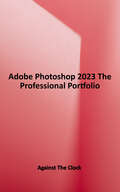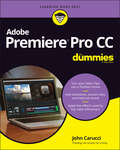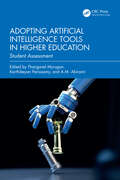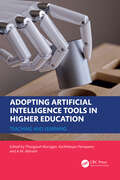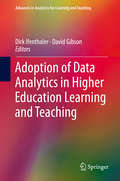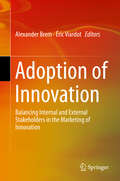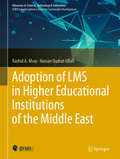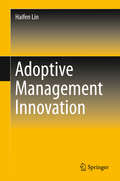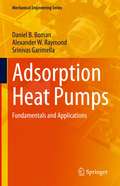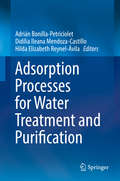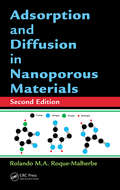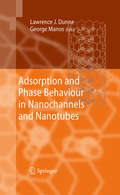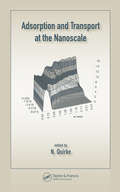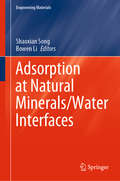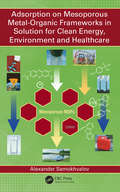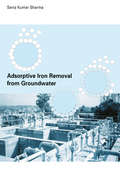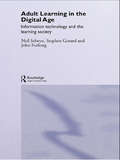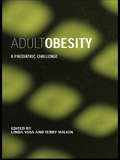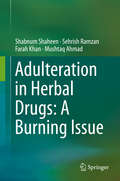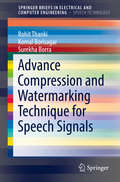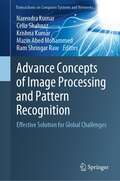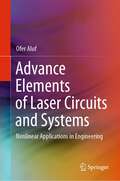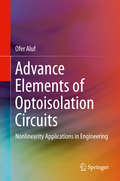- Table View
- List View
Adobe Photoshop 2023: The Professional Portfolio
by Against The ClockSuper Popular Project-Based Series of books designed so that you can Learn while you're building real-world projects. Adobe Photoshop is one of the most universal, versatile, and powerful applications in the professional graphic design toolbox. From compositing multiple images into a single design, to manipulating existing photos, to creating entirely new digital artwork from scratch, the eight projects in this book were designed to reflect a variety of common assignments that you might encounter in your graphic design career. You will learn to: - Define appropriate resolution settings for a variety of distribution media. - Composite raster images, vector objects, and type to create a unified composition. - Use a variety of techniques to separate complicated images from their backgrounds. - Use Photoshop’s powerful controls for repairing and retouching, correcting colors, and adjusting lighting in source images. - Create unique artistic effects using Photoshop’s built-in filters, effects, and brushes. - Work with 3D tools to extend your images beyond two dimensions. - Use valuable time-savers such as styles and actions to streamline your workflow. - Save files with appropriate settings and formats for a variety of print and digital media. - Create graphic and CSS assets for a web design workflow directly within Photoshop.
Adobe Photoshop: Classroom In a Book
by Andrew Faulkner Conrad ChavezThe fastest, easiest, most comprehensive way to learn Adobe Photoshop <p><p> Classroom in a Book®, the best-selling series of hands-on software training workbooks, offers what no other book or training program does -- an official training series from Adobe, developed with the support of Adobe product experts. <p><p> Adobe Photoshop Classroom in a Book (2021 release) contains 15 lessons that cover the basics and beyond, providing countless tips and techniques to help you become more productive with the program. You can follow the book from start to finish or choose only those lessons that interest you. <p><p> What you need to use this book: Adobe Photoshop (2021 release) software, for either Windows or macOS. (Software not included.) <p><p> Note: Classroom in a Book does not replace the documentation, support, updates, or any other benefits of being a registered owner of Adobe Photoshop software.
Adobe Premiere Pro (Classroom in a Book)
by Maxim JagoThe fastest, easiest, most comprehensive way to learn Adobe Premiere Pro Classroom in a Book®, the best-selling series of hands-on software training workbooks, offers what no other book or training program does―an official training series from Adobe, developed with the support of Adobe product experts. <p><p> Adobe Premiere Pro Classroom in a Book (2021 release) contains 17 lessons that cover the basics and beyond, providing countless tips and techniques to help you become more productive with the program. You can follow the book from start to finish or choose only those lessons that interest you.
Adobe Premiere Pro CC For Dummies
by CarucciWhen the filming stops, the real video production work begins Ever wonder how your favorite video creators regularly put out such slick content? They're probably using Adobe Premiere Pro CC, a go-to video production app for both professional and amateur video creators. Adobe Premiere Pro CC For Dummies walks you through each step of editing and producing slick and stylish videos that stand up to what the pros post. From transferring your digital movie files from your camera or phone to your computer all the way to uploading your latest creation to YouTube or the web, this book has the info you need to bring your ideas to life. If you're new to video production, you can begin at the beginning with the handbook's user-friendly guide to the basics of setting clips on the timeline and making them flow seamlessly. Or, if you've already got a few videos under your belt, you can skip right to the more advanced material, like special effects and handy tricks of the trade. You’ll also find: Instruction on joining video clips into a continuous final product, complete with transitions, special effects, and more Advice on improving sound, getting rid of color errors, and customizing the look of your videos with filters and aftereffects Straightforward guides to adding voiceovers and soundtracks to your videos So, if you're new to Adobe Premiere Pro CC—or digital video editing in general—Adobe Premiere Pro CC For Dummies is the first and last resource you'll need to start editing like a pro.
Adopting Artificial Intelligence Tools in Higher Education: Student Assessment
by Thangavel Murugan Karthikeyan Periasamy A. M. AbiramiThis edited volume explores the adoption of artificial intelligence (AI) tools in higher education, specifically focusing on student assessment. It examines the integration of various AI tools within higher education, discussing the challenges and opportunities they present and the innovative solutions they offer.The chapters explore various issues surrounding the use of AI in higher education and propose potential solutions. The book begins with a systematic exploration of AI's potential, presenting innovative ways to ensure fair and accurate assessments that enhance the overall quality of education. It highlights the benefits of AI-powered grading systems that streamline assessment processes, provide timely feedback, and promote fair evaluations. The text discusses how machine learning algorithms can revolutionize assessment methods, allowing individualized, adaptive testing tailored to each student's unique needs. Furthermore, it examines natural language processing (NLP) techniques for evaluating student essays by analyzing linguistic features such as grammar and semantic coherence. Moreover, it highlights AI-powered virtual assistants offering personalized feedback and learning recommendations. Case studies illustrate successful AI assessment implementations and methods for improving AI-based evaluations. The book also addresses engagement and success in the post-COVID-19 context. It raises concerns about plagiarism and academic integrity, comparing AI solutions to traditional methods while exploring the challenges associated with adopting AI in education. Educators, administrators, academics, and technology experts working in institutes of higher learning will find this volume compelling. It is also suitable for students taking courses in educational technology, e-learning, and digital learning.
Adopting Artificial Intelligence Tools in Higher Education: Teaching and Learning
by Thangavel Murugan Karthikeyan Periasamy A. M. AbiramiThis book offers a modern exploration of the intersection of technology and education. It examines the prospects of integrating different AI tools into higher education and explores the challenges, opportunities, and innovative solutions for the different issues surrounding the use of AI in higher education.Each chapter discusses a different area where AI can enhance the educational landscape, such as AI integration in higher education and immersive virtual reality-based learning environments. The book also emphasizes student-centered learning, AI-powered frameworks for academic excellence, and learner-centric pedagogies. Furthermore, it delves into the role of AI in personalized learning in STEM courses, the development of AI-based tutoring systems, and the use of machine learning to identify students’ mental health status. The volume concludes with "Dynamic Horizon," which examines how AI and gamification are shaping higher education.This book is essential for educators, administrators, researchers, and policymakers who want to leverage AI to create an adaptive, personalized, and engaging learning environment. Adopting Artificial Intelligence Tools in Higher Education provides valuable insights into the future of education, paving the way for a more empowered and enlightened academic world.
Adoption of Data Analytics in Higher Education Learning and Teaching (Advances in Analytics for Learning and Teaching)
by David Gibson Dirk IfenthalerThe book aims to advance global knowledge and practice in applying data science to transform higher education learning and teaching to improve personalization, access and effectiveness of education for all. Currently, higher education institutions and involved stakeholders can derive multiple benefits from educational data mining and learning analytics by using different data analytics strategies to produce summative, real-time, and predictive or prescriptive insights and recommendations. Educational data mining refers to the process of extracting useful information out of a large collection of complex educational datasets while learning analytics emphasizes insights and responses to real-time learning processes based on educational information from digital learning environments, administrative systems, and social platforms. This volume provides insight into the emerging paradigms, frameworks, methods and processes of managing change to better facilitate organizational transformation toward implementation of educational data mining and learning analytics. It features current research exploring the (a) theoretical foundation and empirical evidence of the adoption of learning analytics, (b) technological infrastructure and staff capabilities required, as well as (c) case studies that describe current practices and experiences in the use of data analytics in higher education.
Adoption of Innovation: Balancing Internal and External Stakeholders in the Marketing of Innovation
by Alexander Brem Éric ViardotThis edited volume brings together academics from both innovation and marketing fields to explore the additional value for companies that can be generated with the innovations in marketing and the marketing of innovations. If ideas need to reach the marketplace, then marketing strategies, concepts and tools - such as the continuous development of new product and services - become vital for their success. On the other hand, marketing management is influenced by innovation as illustrated by the way social media and Internet have revolutionized the traditional marketing-mix. Such linkages between innovation and marketing research need to be much stronger as companies have to convince internal and external stakeholders to achieve successful innovation strategies. State-of-the-art research output from different perspectives would suit the needs of a researcher as well as the company CEO alike.
Adoption of LMS in Higher Educational Institutions of the Middle East (Advances in Science, Technology & Innovation)
by Hassan Qudrat-Ullah Rashid A. KhanThis book discusses the adoption of learning management systems (LMS) in higher education institutions. It presents influential predictors that may impact instructors’ behavioral intention to adopt learning management systems in the context of Arab culture, as well as a unique model of technology acceptance that draws on and combines previous technology adoption models (i.e., a modified unified theory of acceptance and use of technology model – UTAUT2). Moreover, this study extends the UTAUT2 model by including Hofstede’s (1980) cultural dimensions, and technology awareness as the moderators of the model. It also describes the explanatory technique approach used to collect quantitative data from the instructors at higher education institutions in Saudi Arabia and were analyzed with structural equation modeling using SPSS/Amos software. The findings revealed that facilitating conditions were the strongest predictor of behavioral intention to adopt an LMS, followed by performance expectancy and hedonic motivation, technology awareness, and cultural dimensions exerted a moderating influence on instructors’ behavioral intention to use LMS in their teaching. By including new constructs, this becomes the first study of its kind exploring instructors’ use of LMS in Higher Educational Institutions of Saudi Arabia and other countries of the Middle East. It offers practical insights for a broad range of researchers and professionals at higher education institutions and serves as a reference guide for designers of learning management systems (e.g., blackboard systems), policymakers, and the Ministry of Education staff.
Adoptive Management Innovation
by Haifen LinThis book discusses adoptive management innovation, which has been successfully implemented in other areas. It proposes a theory on this field by considering the importance and popularity of adoptive management innovation in China and around the globe, and focusing on its nature. It also establishes a process framework through which adoptive management innovation occurs, explores how individual characteristics of individual managers affect their adoption decision, examines the effects of a firm’s dynamic capability on each phase of adoptive innovation, and addresses how intangible management innovation supports the process of tangible product innovation to produce effects. By exploring the process, adoption decision, drivers and effects of adoptive management innovation, the book offers abundant applications for managerial practice
Adsorption Heat Pumps: Fundamentals and Applications (Mechanical Engineering Series)
by Daniel B. Boman Alexander W. Raymond Srinivas GarimellaThis volume introduces the fundamentals of adsorption heat pumps, beginning with the simplest cycle and building to the most complex. Selection of adsorbents and refrigerants, design of adsorption beds and auxiliary heat exchangers, and applications for different designs are all discussed. The book educates engineering students, engineers, and researchers about an environmentally friendly alternative to vapor compression refrigeration systems promising for many applications. The authors cover thermodynamic cycles, working materials for the cycles, and aspects of designing and modeling adsorption heat pumps.Elucidates the various applications of adsorption heat pumps;Illustrates modeling techniques for quickly screening new working materials early in their development;Provides comprehensive review of cycle types, with discussion of the applications for which they are best suited;Appropriate for graduate courses on advanced thermodynamics, design of thermal systems, sustainable energy technology, refrigeration technologies, and thermal control of electronics.
Adsorption Processes for Water Treatment and Purification
by Adrián Bonilla-Petriciolet Didilia Ileana Mendoza-Castillo Hilda Elizabeth Reynel-ÁvilaThis book provides researchers and graduate students with an overview of the latest developments in and applications of adsorption processes for water treatment and purification. In particular, it covers current topics in connection with the modeling and design of adsorption processes, and the synthesis and application of cost-effective adsorbents for the removal of relevant aquatic pollutants. The book describes recent advances and alternatives to improve the performance and efficacy of this water purification technique. In addition, selected chapters are devoted to discussing the reliable modeling and analysis of adsorption data, which are relevant for real-life applications to industrial effluents and groundwater.
Adsorption and Diffusion in Nanoporous Materials
by Rolando Roque-MalherbeOffering a materials science point of view, the author covers the theory and practice of adsorption and diffusion applied to gases in microporous crystalline, mesoporous ordered, and micro/mesoporous amorphous materials. Examples used include microporous and mesoporous molecular sieves, amorphous silica, and alumina and active carbons, akaganeites, prussian blue analogues, metal organic frameworks and covalent organic frameworks. The use of single component adsorption, diffusion in the characterization of the adsorbent surface, pore volume, pore size distribution, and the study of the parameters characterizing single component transport processes in porous materials are detailed.
Adsorption and Phase Behaviour in Nanochannels and Nanotubes
by Lawrence J. Dunne George ManosChannels of nanotubular dimensions exist in a variety of materials (examples are carbon nanotubes and the nanotubular channels of zeolites and zeotypes) and show promise for numerous applications due to their unique properties. One of their most important properties is their capacity to adsorb molecules and these may exist in a variety of phases. "Adsorption and Phase Behaviour in Nanochannels and Nanotubes" provides an excellent review of recent and current work on adsorption on nanometerials. It is an impressive collection of papers dealing with the adsorption and phase behaviour in nanoporous materials from both experimental and theoretical perspectives. "Adsorption and Phase Behaviour in Nanochannels and Nanotubes" focuses on carbon nanotubes as well as zeolites and related materials.
Adsorption and Transport at the Nanoscale
by Nick QuirkeNanoporous materials are used widely in industry as adsorbents, particularly for applications where selective adsorption of one fluid component from a mixture is important. Nanoscale structures are of increasing interest for micro- and nanofluidic devices. Computational methods have an important role to play in characterizing, understanding, and de
Adsorption at Natural Minerals/Water Interfaces (Engineering Materials)
by Bowen Li Shaoxian SongThis book introduces the latest research regarding the adsorption of heavy metals, toxic ions, and organic compounds at the interfaces of water/minerals, such as mineralogical characterizations, surface chemistry, and modification of natural minerals as adsorbents, as well as the adsorption of cations, anions, and organic compounds in water. Presenting findings by the authors and their co-workers, the book helps readers grasp the principals and benefits of using minerals for water treatment, as well as the advanced technologies in the area developed over last 30 years, especially the last 10 years.
Adsorption on Mesoporous Metal-Organic Frameworks in Solution for Clean Energy, Environment and Healthcare
by Alexander SamokhvalovAdsorption and desorption in solution play significant roles in separations, detoxification of waste streams, in purification, chromatography, heterogeneous catalysis, metabolism of medicinal drugs, and beyond. Metal-Organic Frameworks (MOFs) are well-ordered 3-dimensional hybrid organic-inorganic polymers which contain metal cations and the structure-building organic "linker" units. Mesoporous MOFs with pore sizes 2-50 nm are particularly suitable for adsorption and adsorption-based separations of large molecules of organic and bio-organic compounds. Thousands of organic compounds and, in particular, aromatic and heterocyclic compounds are widely used as feedstock for industrial chemical synthesis, as fine chemicals, major components of liquid fossil fuels, dyestuffs, industrial solvents, agricultural chemicals, medicinal drugs, pharmaceuticals and personal care products (PPCPs), and active pharmaceutical ingredients (APIs). There is a strong interest towards synthesis, characterization and studies of both known and newly synthesized mesoporous MOFs for adsorption in solution to achieve the high adsorption capacity, selectivity, and the possibility of multiple regeneration of "spent" sorbent. This book covers experimental fundamental research on using mesoporous MOFs in emerging applications of major industrial, environmental and academic importance, especially purification of water and liquid fossil fuels and in advanced biomedical technologies.
Adsorptive Iron Removal from Groundwater
by Sharoz Kumar SharmaA pilot study conducted at the Gilze water treatment plant of Water Supply North West Brabant demonstrated that adsorptive filtration has several potential advantages over floc filtration, namely: longer filter runs due to slower head loss development; better filtrate quality; shorter ripening time; and less backwash water use. In existing groundwater treatment plants, the high iron (II) adsorption capacity of the iron oxide coated filter media makes it potentially possible to switch the governing mode of operation from floc filtration to adsorptive filtration. To achieve this two options can be considered: iron (II) adsorption under anoxic conditions followed by oxidation with oxygen-rich water; and adsorption of iron (II) in the presence of oxygen and simultaneous oxidation. The first option might be attractive specifically when two filtration steps are available.
Adult Learning in the Digital Age: Information Technology and the Learning Society
by John Furlong Stephen Gorard Neil SelwynThis engaging book sheds light on the ways in which adults in the twenty-first century interact with technology in different learning environments. Based on one of the first large-scale academic research projects in this area, the authors present their findings and offer practical recommendations for the use of new technology in a learning society. They invite debate on: why ICTs are believed to be capable of affecting positive change in adult learning the drawbacks and limits of ICT in adult education what makes a lifelong learner the wider social, economic, cultural and political realities of the information age and the learning society. Adult Learning addresses key questions and provides a sound empirical foundation to the existing debate, highlighting the complex realities of the learning society and e-learning rhetoric. It tells the story of those who are excluded from the learning society, and offers a set of strong recommendations for practitioners, policy-makers, and politicians, as well as researchers and students.
Adult Obesity: A Paediatric Challenge
by Linda D. Voss Terence J. WilkinWhile it is increasingly clear that adult obesity begins in childhood, preventing this condition is a major challenge for the pediatrician.Adult Obesity: A Paediatric Challenge highlights the causes and consequences of obesity, bringing a modern understanding to the treatment of a heavily stigmatized problem. This collection of essays, base
Adulteration in Herbal Drugs: A Burning Issue
by Mushtaq Ahmad Shabnum Shaheen Sehrish Ramzan Farah KhanSubstitution and adulteration in traded herbal raw material are common practice in the herbal industry due to the extinction of required species, deforestation and incorrect taxonomical identification. Herbalists have adopted methods to create high quality adulteration which cannot be detected without performing microscopic examination or chemical analysis. It is difficult to establish specific quality control standards due to the complex nature and innate unpredictability of the chemical constituents of medicinal herbs.The main parameters for measurement and adulteration prevention in medicinal herbs are morphological and microscopic investigation, chemical profiling and DNA barcoding. The need for highly sensitive and more effective approaches for the authentication of medicinal herbs is necessary in order to promote the acceptance of herbal products. Adulteration In Traditional Medicinal Herbs is aimed at promoting awareness of adulteration in traditional herbal medicines for the worldwide scientific community. Parameters are established for the prevention of adulteration through classical and modern scientific tools. Valuable case studies are presented based on ethno-medicinal surveys performed in many herbal markets in Pakistan. Collections of various samples were obtained from these shops then compared with the original plants collected from field. Various phytochemical, organoleptic and DNA barcoding techniques were used in order to detect adulteration in the marketed herbal samples. This book is the first of its kind and is aimed at helping the scientific community to identify particular medicinal plants which are facing adulteration problems in herbal markets and to estimate the extent of adulteration and substitution in commonly used medicinal herbs.
Advance Compression and Watermarking Technique for Speech Signals (SpringerBriefs in Speech Technology)
by Rohit Thanki Komal Borisagar Surekha BorraThis book introduces methods for copyright protection and compression for speech signals. The first method introduces copyright protection of speech signal using watermarking; the second introduces compression of the speech signal using Compressive Sensing (CS). Both methods are tested and analyzed. The speech watermarking method uses technology such as Finite Ridgelet Transform (FRT), Discrete Wavelet Transform (DWT) and Singular Value Decomposition (SVD). The performance of the method is evaluated and compared with existing watermarking methods. In the speech compression method, the standard Compressive Sensing (CS) process is used for compression of the speech signal. The performance of the proposed method is evaluated using various transform bases like Discrete Fourier Transform (DFT), Discrete Cosine Transform (DCT), Discrete Wavelet Transform (DWT), Singular Value Decomposition (SVD), and Fast Discrete Curvelet Transform (FDCuT).
Advance Concepts of Image Processing and Pattern Recognition: Effective Solution for Global Challenges (Transactions on Computer Systems and Networks)
by Krishna Kumar Narendra Kumar Celia Shahnaz Mazin Abed Mohammed Ram Shringar RawThe book explains the important concepts and principles of image processing to implement the algorithms and techniques to discover new problems and applications. It contains numerous fundamental and advanced image processing algorithms and pattern recognition techniques to illustrate the framework. It presents essential background theory, shape methods, texture about new methods, and techniques for image processing and pattern recognition. It maintains a good balance between a mathematical background and practical implementation. This book also contains the comparison table and images that are used to show the results of enhanced techniques. This book consists of novel concepts and hybrid methods for providing effective solutions for society. It also includes a detailed explanation of algorithms in various programming languages like MATLAB, Python, etc. The security features of image processing like image watermarking and image encryption etc. are also discussed in this book. This book will be useful for those who are working in the field of image processing, pattern recognition, and security for digital images. This book targets researchers, academicians, industry, and professionals from R&D organizations, and students, healthcare professionals working in the field of medical imaging, telemedicine, cybersecurity, data scientist, artificial intelligence, image processing, digital hospital, intelligent medicine.
Advance Elements of Laser Circuits and Systems: Nonlinear Applications in Engineering
by Ofer AlufThis book on Advance Elements of Laser circuits and systems Nonlinearity applications in engineering addresses two separate engineering and scientific areas, and presents advanced analysis methods for Laser circuits and systems that cover a broad range of engineering and scientific applications. The book analyzed Laser circuits and systems as linear and nonlinear dynamical systems and there limit cycles, bifurcation, and limit cycle stability by using nonlinear dynamic theory. Further, it discussed a broad range of bifurcations related to Laser systems and circuits, starting from laser system differential equations and their bifurcations, delay differential equations (DDEs) are a function of time delays, delay dependent parameters, followed by phase plane analysis, limit cycles and their bifurcations, chaos, iterated maps, period doubling. It combines graphical information with analytical analysis to effectively study the local stability of Laser systems models involving delay dependent parameters. Specifically, the stability of a given steady state is determined by the graphs of some functions of which can be expressed explicitly. The Laser circuits and systems are Laser diode circuits, MRI system Laser diode circuitry, Electron-photon exchanges into VCSEL, Ti: Sapphire laser systems, Ion channel and long-wavelength lasers, Solid state lasers, Solid state laser controlled by semiconductor devices, microchip solid-state laser, Q-switched diode-pumped solid-state laser, Nd:YAG, Mid-Infrared and Q-switched microchip lasers, Gas laser systems, copper vapor laser (CVL) circuitry, Dual-wavelength laser systems, Dual-wavelength operation of a Ti:sapphire laser, Diode-pumped Q-switched Nd:YVO4 yellow laser, Asymmetric dual quantum well lasers, Tm3+-doped silica fibre lasers, Terahertz dual-wavelength quantum cascade laser. The Book address also the additional areas, Laser X guiding system, Plasma diagnostics, Laser Beam shaping, Jitter and crosstalk, Plasma mirror systems, and High power Laser/Target diagnostic system optical elements. The book is unique in its emphasis on practical and innovative engineering and scientific applications. All conceptual Laser circuits are innovative and can be broadly implemented in many engineering applications. The dynamics of Laser circuits and systems provides several ways to use them in a variety of applications covering wide areas. This book is aimed at electrical and electronics engineers, students and researchers in physics as well. It is also aimed for research institutes in lasers and plasma physics and gives good comprehensive in laser and plasma systems. In each chapter, the concept is developed from basic assumptions up to the final engineering and scientific outcomes. The scientific background is explained at basic and advance levels and closely integrated with mathematical theory. Many examples are presented in this book and it is also ideal for intermediate level courses at graduate level studies. It is also ideal for engineer who has not had formal instruction in nonlinear dynamics, but who now desires to fill the gap between innovative Laser circuits/systems and advance mathematical analysis methods.
Advance Elements of Optoisolation Circuits: Nonlinearity Applications in Engineering
by Ofer AlufThis book on advanced optoisolation circuits for nonlinearity applications in engineering addresses two separate engineering and scientific areas, and presents advanced analysis methods for optoisolation circuits that cover a broad range of engineering applications. The book analyzes optoisolation circuits as linear and nonlinear dynamical systems and their limit cycles, bifurcation, and limit cycle stability by using Floquet theory. Further, it discusses a broad range of bifurcations related to optoisolation systems: cusp-catastrophe, Bautin bifurcation, Andronov-Hopf bifurcation, Bogdanov-Takens (BT) bifurcation, fold Hopf bifurcation, Hopf-Hopf bifurcation, Torus bifurcation (Neimark-Sacker bifurcation), and Saddle-loop or Homoclinic bifurcation. Floquet theory helps as to analyze advance optoisolation systems. Floquet theory is the study of the stability of linear periodic systems in continuous time. Another way to describe Floquet theory, it is the study of linear systems of differential equations with periodic coefficients. The optoisolation system displays a rich variety of dynamical behaviors including simple oscillations, quasi-periodicity, bi-stability between periodic states, complex periodic oscillations (including the mixed-mode type), and chaos. The route to chaos in this optoisolation system involves a torus attractor which becomes destabilized and breaks up into a fractal object, a strange attractor. The book is unique in its emphasis on practical and innovative engineering applications. These include optocouplers in a variety of topological structures, passive components, conservative elements, dissipative elements, active devices, etc. In each chapter, the concept is developed from the basic assumptions up to the final engineering outcomes. The scientific background is explained at basic and advanced levels and closely integrated with mathematical theory. The book is primarily intended for newcomers to linear and nonlinear dynamics and advanced optoisolation circuits, as well as electrical and electronic engineers, students and researchers in physics who read the first book "Optoisolation Circuits Nonlinearity Applications in Engineering". It is ideally suited for engineers who have had no formal instruction in nonlinear dynamics, but who now desire to bridge the gap between innovative optoisolation circuits and advanced mathematical analysis methods.
